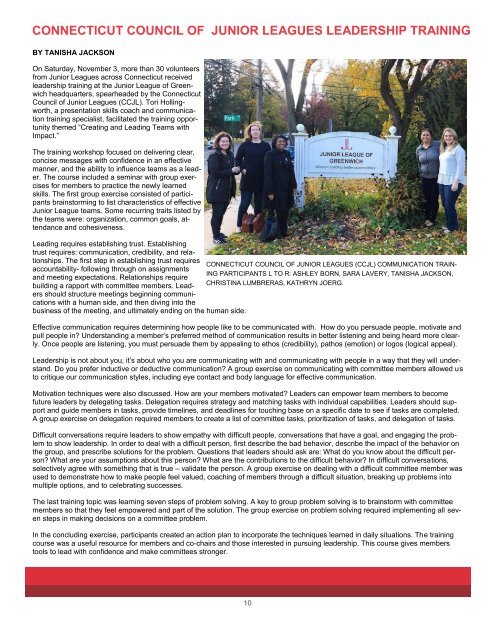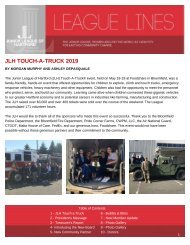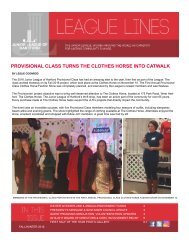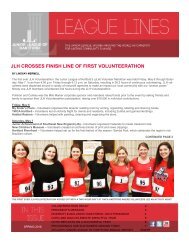JLH League Lines - Fall and Winter 2018 - 2019 FINAL
Create successful ePaper yourself
Turn your PDF publications into a flip-book with our unique Google optimized e-Paper software.
CONNECTICUT COUNCIL OF JUNIOR LEAGUES LEADERSHIP TRAINING<br />
BY TANISHA JACKSON<br />
On Saturday, November 3, more than 30 volunteers<br />
from Junior <strong>League</strong>s across Connecticut received<br />
leadership training at the Junior <strong>League</strong> of Greenwich<br />
headquarters, spearheaded by the Connecticut<br />
Council of Junior <strong>League</strong>s (CCJL). Tori Hollingworth,<br />
a presentation skills coach <strong>and</strong> communication<br />
training specialist, facilitated the training opportunity<br />
themed “Creating <strong>and</strong> Leading Teams with<br />
Impact.”<br />
The training workshop focused on delivering clear,<br />
concise messages with confidence in an effective<br />
manner, <strong>and</strong> the ability to influence teams as a leader.<br />
The course included a seminar with group exercises<br />
for members to practice the newly learned<br />
skills. The first group exercise consisted of participants<br />
brainstorming to list characteristics of effective<br />
Junior <strong>League</strong> teams. Some recurring traits listed by<br />
the teams were: organization, common goals, attendance<br />
<strong>and</strong> cohesiveness.<br />
Leading requires establishing trust. Establishing<br />
trust requires: communication, credibility, <strong>and</strong> relationships.<br />
The first step in establishing trust requires<br />
CONNECTICUT COUNCIL OF JUNIOR LEAGUES (CCJL) COMMUNICATION TRAINaccountability-<br />
following through on assignments<br />
ING PARTICIPANTS L TO R: ASHLEY BORN, SARA LAVERY, TANISHA JACKSON,<br />
<strong>and</strong> meeting expectations. Relationships require<br />
building a rapport with committee members. Leaders<br />
should structure meetings beginning communi-<br />
CHRISTINA LUMBRERAS, KATHRYN JOERG.<br />
cations with a human side, <strong>and</strong> then diving into the<br />
business of the meeting, <strong>and</strong> ultimately ending on the human side.<br />
Effective communication requires determining how people like to be communicated with. How do you persuade people, motivate <strong>and</strong><br />
pull people in? Underst<strong>and</strong>ing a member’s preferred method of communication results in better listening <strong>and</strong> being heard more clearly.<br />
Once people are listening, you must persuade them by appealing to ethos (credibility), pathos (emotion) or logos (logical appeal).<br />
Leadership is not about you, it’s about who you are communicating with <strong>and</strong> communicating with people in a way that they will underst<strong>and</strong>.<br />
Do you prefer inductive or deductive communication? A group exercise on communicating with committee members allowed us<br />
to critique our communication styles, including eye contact <strong>and</strong> body language for effective communication.<br />
Motivation techniques were also discussed. How are your members motivated? Leaders can empower team members to become<br />
future leaders by delegating tasks. Delegation requires strategy <strong>and</strong> matching tasks with individual capabilities. Leaders should support<br />
<strong>and</strong> guide members in tasks, provide timelines, <strong>and</strong> deadlines for touching base on a specific date to see if tasks are completed.<br />
A group exercise on delegation required members to create a list of committee tasks, prioritization of tasks, <strong>and</strong> delegation of tasks.<br />
Difficult conversations require leaders to show empathy with difficult people, conversations that have a goal, <strong>and</strong> engaging the problem<br />
to show leadership. In order to deal with a difficult person, first describe the bad behavior, describe the impact of the behavior on<br />
the group, <strong>and</strong> prescribe solutions for the problem. Questions that leaders should ask are: What do you know about the difficult person?<br />
What are your assumptions about this person? What are the contributions to the difficult behavior? In difficult conversations,<br />
selectively agree with something that is true – validate the person. A group exercise on dealing with a difficult committee member was<br />
used to demonstrate how to make people feel valued, coaching of members through a difficult situation, breaking up problems into<br />
multiple options, <strong>and</strong> to celebrating successes.<br />
The last training topic was learning seven steps of problem solving. A key to group problem solving is to brainstorm with committee<br />
members so that they feel empowered <strong>and</strong> part of the solution. The group exercise on problem solving required implementing all seven<br />
steps in making decisions on a committee problem.<br />
In the concluding exercise, participants created an action plan to incorporate the techniques learned in daily situations. The training<br />
course was a useful resource for members <strong>and</strong> co-chairs <strong>and</strong> those interested in pursuing leadership. This course gives members<br />
tools to lead with confidence <strong>and</strong> make committees stronger.<br />
10














